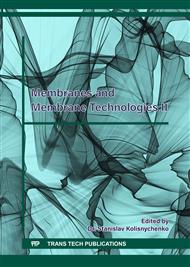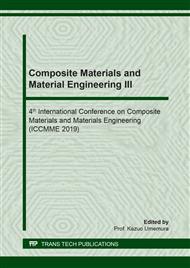p.304
p.313
p.319
p.325
p.331
p.337
p.345
p.351
p.357
Effect of Polysulfone/Organomontmorillonite Blends on Nanocomposite Membrane Properties
Abstract:
In this study, an organically modified montmorillonite (OMMT) hydrophilic clay was incorporated in PSf through non-solvent induced phase separation fabrication process to improve its properties. Afterwards, hand casting was done and the PSf/OMMT membranes produced were characterized to determine the effect of OMMT addition to its structural, mechanical and thermal properties, and hydrophilicity. Scanning electron microscope (SEM) images of the surfaces showed a denser surface as the OMMT content increases but the pores on the images were not pronounced unlike the SEM images of the cross-section which depicted spherical macrovoids for 1.0% while wider macrovoids were observed for 3.0% and 5.0% OMMT. The mechanical properties of the nanocomposite with clay content up to 3.0% were improved. The glass transition temperatures of the PSf/OMMT nanocomposites were lower than the pure PSf while no significant difference was observed for the melting point. By statistical analysis, the addition and variation of the clay concentrations has no significant effect to the thermal properties. The hydrophilicity of the membranes improved with the increasing OMMT concentration, but was found to be insignificant. The overall data gathered showed that the clay addition had improved characteristics compared to the pure PSf membrane, which implies that PSf/OMMT nanocomposite could be likely used in filtration applications.
Info:
Periodical:
Pages:
331-336
Citation:
Online since:
May 2019
Price:
Сopyright:
© 2019 Trans Tech Publications Ltd. All Rights Reserved
Share:
Citation:



